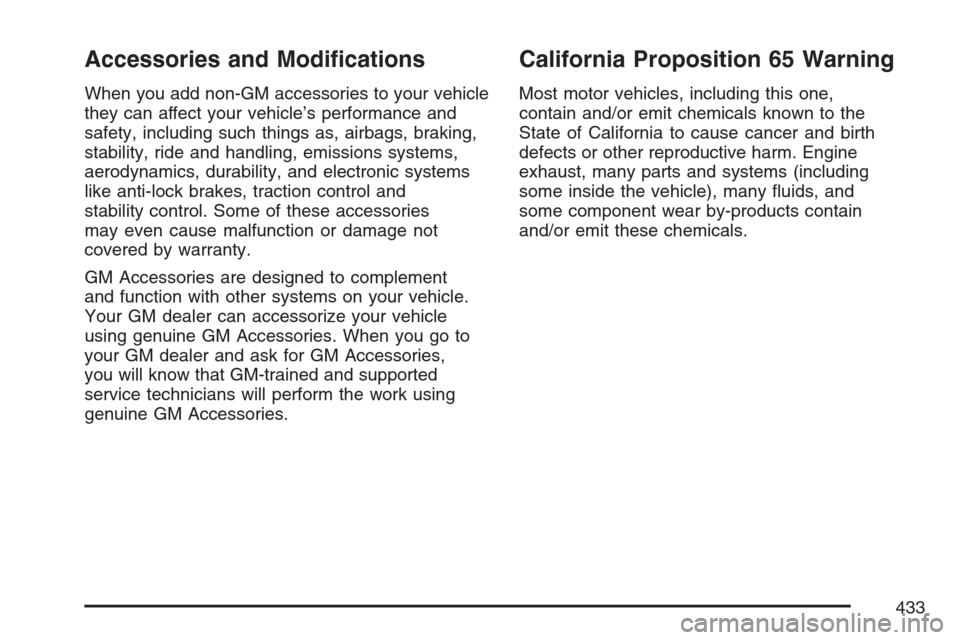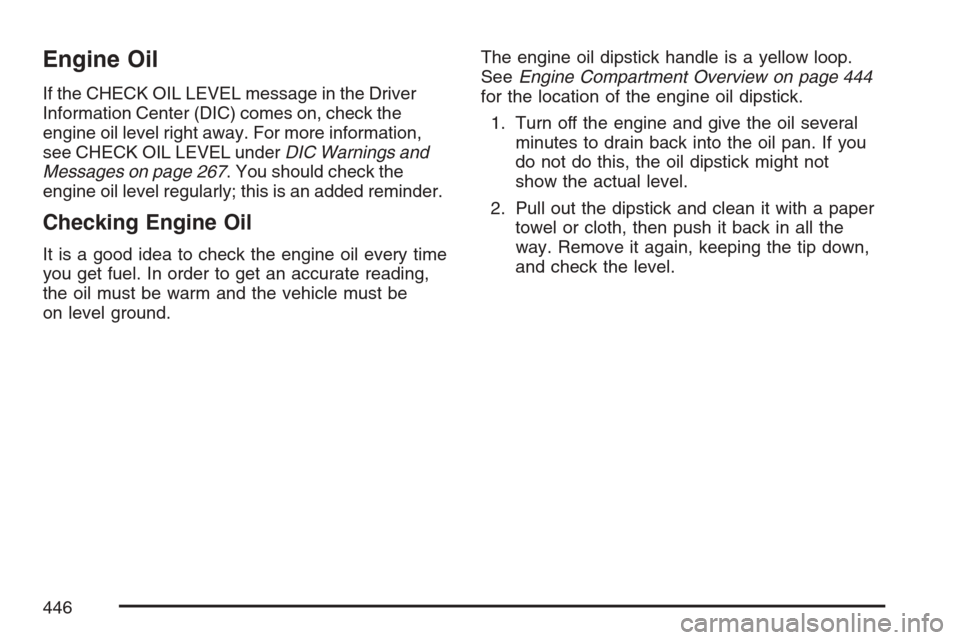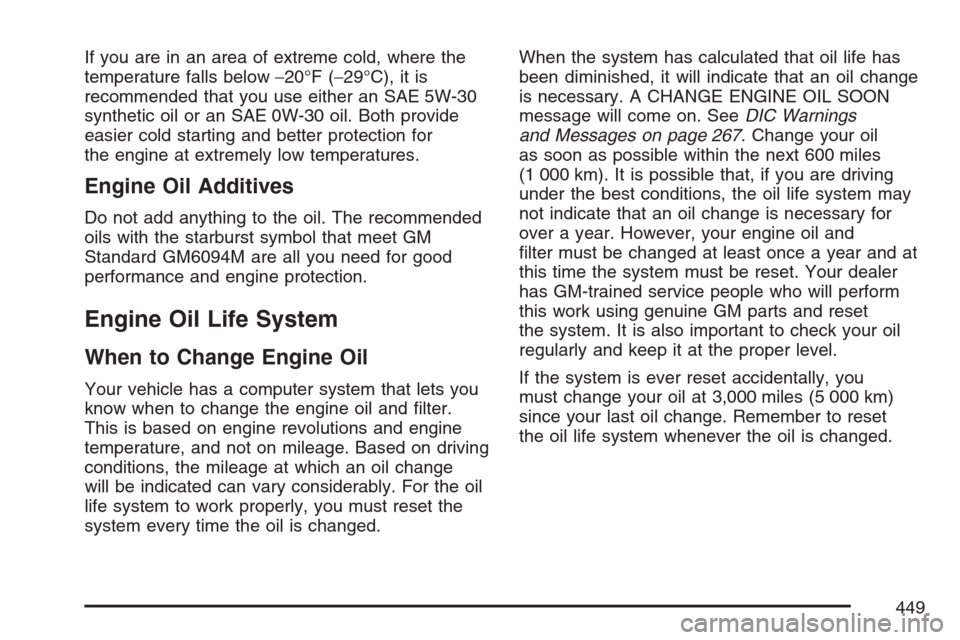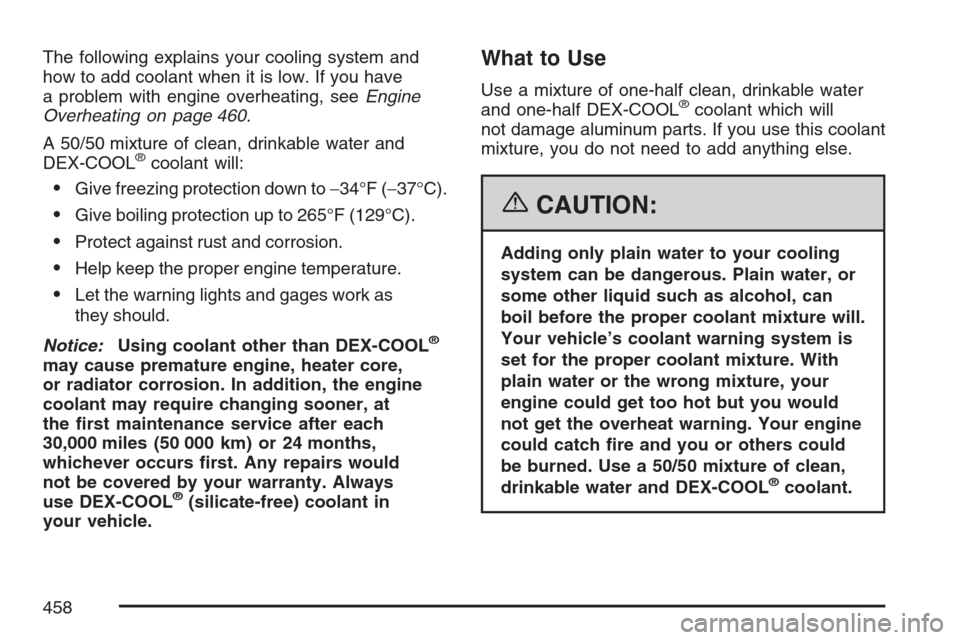2007 CHEVROLET AVALANCHE warning
[x] Cancel search: warningPage 424 of 618

Driving On Grades
Reduce speed and shift to a lower gearbefore
you start down a long or steep downgrade. If you
don’t shift down, you might have to use your
brakes so much that they would get hot and no
longer work well.
You can tow in DRIVE (D). You may want to shift
the transmission to THIRD (3) or, if necessary,
a lower gear selection if the transmission shifts too
often (e.g., under heavy loads and/or hilly
conditions).
You may also want to activate the tow/haul mode
if the transmission shifts too often. See “Tow/Haul
Mode” earlier in this section.
When towing at high altitude on steep uphill
grades, consider the following: Engine coolant
at higher altitudes will boil at a lower temperature
than at or near sea level. If you turn your
engine off immediately after towing at high
altitude on steep uphill grades, your vehicle
may show signs similar to engine overheating.To avoid this, let the engine run while parked
(preferably on level ground) with the automatic
transmission in PARK (P) for a few minutes before
turning the engine off. If you do get the overheat
warning, seeEngine Overheating on page 460.
Parking on Hills
{CAUTION:
You really should not park your
vehicle, with a trailer attached, on a hill.
If something goes wrong, your rig could
start to move. People can be injured,
and both your vehicle and the trailer
can be damaged.
But if you ever have to park your rig on a hill,
here’s how to do it:
1. Apply your regular brakes, but don’t shift into
PARK (P) yet.
2. Have someone place chocks under the trailer
wheels.
424
Page 429 of 618

Service........................................................ 432
Accessories and Modi�cations................... 433
California Proposition 65 Warning.............. 433
Doing Your Own Service Work.................. 434
Adding Equipment to the Outside
of Your Vehicle...................................... 435
Fuel............................................................. 435
Gasoline Octane........................................ 436
Gasoline Speci�cations.............................. 436
California Fuel........................................... 436
Additives................................................... 437
Fuel E85 (85% Ethanol)............................ 438
Fuels in Foreign Countries........................ 439
Filling the Tank......................................... 440
Filling a Portable Fuel Container............... 442
Checking Things Under the Hood.............. 442
Hood Release........................................... 443
Engine Compartment Overview.................. 444
Engine Oil................................................. 446
Engine Oil Life System.............................. 449Engine Air Cleaner/Filter............................ 451
Automatic Transmission Fluid.................... 454
Engine Coolant.......................................... 457
Coolant Surge Tank Pressure Cap............ 460
Engine Overheating................................... 460
Overheated Engine Protection
Operating Mode..................................... 463
Cooling System......................................... 464
Engine Fan Noise..................................... 469
Power Steering Fluid ................................. 469
Windshield Washer Fluid........................... 470
Brakes...................................................... 472
Battery...................................................... 475
Jump Starting............................................ 476
Rear Axle.................................................... 482
Four-Wheel Drive........................................ 483
Front Axle................................................... 484
Headlamp Aiming........................................ 485
Section 5 Service and Appearance Care
429
Page 433 of 618

Accessories and Modi�cations
When you add non-GM accessories to your vehicle
they can affect your vehicle’s performance and
safety, including such things as, airbags, braking,
stability, ride and handling, emissions systems,
aerodynamics, durability, and electronic systems
like anti-lock brakes, traction control and
stability control. Some of these accessories
may even cause malfunction or damage not
covered by warranty.
GM Accessories are designed to complement
and function with other systems on your vehicle.
Your GM dealer can accessorize your vehicle
using genuine GM Accessories. When you go to
your GM dealer and ask for GM Accessories,
you will know that GM-trained and supported
service technicians will perform the work using
genuine GM Accessories.
California Proposition 65 Warning
Most motor vehicles, including this one,
contain and/or emit chemicals known to the
State of California to cause cancer and birth
defects or other reproductive harm. Engine
exhaust, many parts and systems (including
some inside the vehicle), many �uids, and
some component wear by-products contain
and/or emit these chemicals.
433
Page 441 of 618

{CAUTION:
If you spill fuel and then something
ignites it, you could be badly burned.
Fuel can spray out on you if you open
the fuel cap too quickly. This spray can
happen if your tank is nearly full, and is
more likely in hot weather. Open the fuel
cap slowly and wait for any hiss noise to
stop. Then unscrew the cap all the way.
Be careful not to spill fuel. Do not top off or over�ll
the tank and wait a few seconds after you have
�nished pumping before removing the nozzle.
Clean fuel from painted surfaces as soon as
possible. SeeWashing Your Vehicle on page 541.
When replacing the fuel cap, turn it clockwise
until it clicks. It will require more effort to turn
the fuel cap on the last turn as you tighten it.
Make sure the cap is fully installed. The diagnostic
system can determine if the fuel cap has been
left off or improperly installed. This would allow
fuel to evaporate into the atmosphere. See
Malfunction Indicator Lamp on page 250.The TIGHTEN GAS CAP message will be
displayed on the Driver Information Center (DIC)
if the fuel cap is not properly installed. See
DIC Warnings and Messages on page 267for
more information.
{CAUTION:
If a �re starts while you are refueling,
do not remove the nozzle. Shut off the
�ow of fuel by shutting off the pump
or by notifying the station attendant.
Leave the area immediately.
Notice:If you need a new fuel cap, be sure
to get the right type. Your dealer can get
one for you. If you get the wrong type,
it may not �t properly. This may cause your
malfunction indicator lamp to light and
may damage your fuel tank and emissions
system. SeeMalfunction Indicator Lamp
on page 250.
441
Page 446 of 618

Engine Oil
If the CHECK OIL LEVEL message in the Driver
Information Center (DIC) comes on, check the
engine oil level right away. For more information,
see CHECK OIL LEVEL underDIC Warnings and
Messages on page 267. You should check the
engine oil level regularly; this is an added reminder.
Checking Engine Oil
It is a good idea to check the engine oil every time
you get fuel. In order to get an accurate reading,
the oil must be warm and the vehicle must be
on level ground.The engine oil dipstick handle is a yellow loop.
SeeEngine Compartment Overview on page 444
for the location of the engine oil dipstick.
1. Turn off the engine and give the oil several
minutes to drain back into the oil pan. If you
do not do this, the oil dipstick might not
show the actual level.
2. Pull out the dipstick and clean it with a paper
towel or cloth, then push it back in all the
way. Remove it again, keeping the tip down,
and check the level.
446
Page 449 of 618

If you are in an area of extreme cold, where the
temperature falls below−20°F (−29°C), it is
recommended that you use either an SAE 5W-30
synthetic oil or an SAE 0W-30 oil. Both provide
easier cold starting and better protection for
the engine at extremely low temperatures.
Engine Oil Additives
Do not add anything to the oil. The recommended
oils with the starburst symbol that meet GM
Standard GM6094M are all you need for good
performance and engine protection.
Engine Oil Life System
When to Change Engine Oil
Your vehicle has a computer system that lets you
know when to change the engine oil and �lter.
This is based on engine revolutions and engine
temperature, and not on mileage. Based on driving
conditions, the mileage at which an oil change
will be indicated can vary considerably. For the oil
life system to work properly, you must reset the
system every time the oil is changed.When the system has calculated that oil life has
been diminished, it will indicate that an oil change
is necessary. A CHANGE ENGINE OIL SOON
message will come on. SeeDIC Warnings
and Messages on page 267. Change your oil
as soon as possible within the next 600 miles
(1 000 km). It is possible that, if you are driving
under the best conditions, the oil life system may
not indicate that an oil change is necessary for
over a year. However, your engine oil and
�lter must be changed at least once a year and at
this time the system must be reset. Your dealer
has GM-trained service people who will perform
this work using genuine GM parts and reset
the system. It is also important to check your oil
regularly and keep it at the proper level.
If the system is ever reset accidentally, you
must change your oil at 3,000 miles (5 000 km)
since your last oil change. Remember to reset
the oil life system whenever the oil is changed.
449
Page 450 of 618

How to Reset the Engine Oil Life
System
The Engine Oil Life System calculates when to
change your engine oil and �lter based on vehicle
use. Anytime your oil is changed, reset the
system so it can calculate when the next oil
change is required. If a situation occurs where you
change your oil prior to a CHANGE ENGINE
OIL SOON message coming on, reset the system.
Always reset the engine oil life to 100% after
every oil change. It will not reset itself. To reset
the Engine Oil Life System, do the following:
1. Display the OIL LIFE REMAINING on the DIC.
If your vehicle does not have DIC buttons, the
vehicle must be in PARK (P) to access this
display. SeeDIC Operation and Displays
(With DIC Buttons) on page 258orDIC
Operation and Displays (Without DIC Buttons)
on page 264.
2. Press and hold the SET/RESET button on
the DIC, or the trip odometer reset stem if
your vehicle does not have DIC buttons,
for more than �ve seconds. The oil life will
change to 100%.If the CHANGE ENGINE OIL SOON message
comes back on when you start your vehicle, the
Engine Oil Life System has not reset. Repeat
the procedure.
What to Do with Used Oil
Used engine oil contains certain elements that may
be unhealthy for your skin and could even cause
cancer. Do not let used oil stay on your skin for very
long. Clean your skin and nails with soap and
water, or a good hand cleaner. Wash or properly
dispose of clothing or rags containing used engine
oil. See the manufacturer’s warnings about the use
and disposal of oil products.
Used oil can be a threat to the environment. If you
change your own oil, be sure to drain all the oil from
the �lter before disposal. Never dispose of oil by
putting it in the trash, pouring it on the ground, into
sewers, or into streams or bodies of water. Instead,
recycle it by taking it to a place that collects used
oil. If you have a problem properly disposing of
used oil, ask your dealer, a service station, or a
local recycling center for help.
450
Page 458 of 618

The following explains your cooling system and
how to add coolant when it is low. If you have
a problem with engine overheating, seeEngine
Overheating on page 460.
A 50/50 mixture of clean, drinkable water and
DEX-COOL
®coolant will:
Give freezing protection down to−34°F (−37°C).
Give boiling protection up to 265°F (129°C).
Protect against rust and corrosion.
Help keep the proper engine temperature.
Let the warning lights and gages work as
they should.
Notice:Using coolant other than DEX-COOL
®
may cause premature engine, heater core,
or radiator corrosion. In addition, the engine
coolant may require changing sooner, at
the �rst maintenance service after each
30,000 miles (50 000 km) or 24 months,
whichever occurs �rst. Any repairs would
not be covered by your warranty. Always
use DEX-COOL
®(silicate-free) coolant in
your vehicle.
What to Use
Use a mixture of one-half clean, drinkable water
and one-half DEX-COOL®coolant which will
not damage aluminum parts. If you use this coolant
mixture, you do not need to add anything else.
{CAUTION:
Adding only plain water to your cooling
system can be dangerous. Plain water, or
some other liquid such as alcohol, can
boil before the proper coolant mixture will.
Your vehicle’s coolant warning system is
set for the proper coolant mixture. With
plain water or the wrong mixture, your
engine could get too hot but you would
not get the overheat warning. Your engine
could catch �re and you or others could
be burned. Use a 50/50 mixture of clean,
drinkable water and DEX-COOL
®coolant.
458